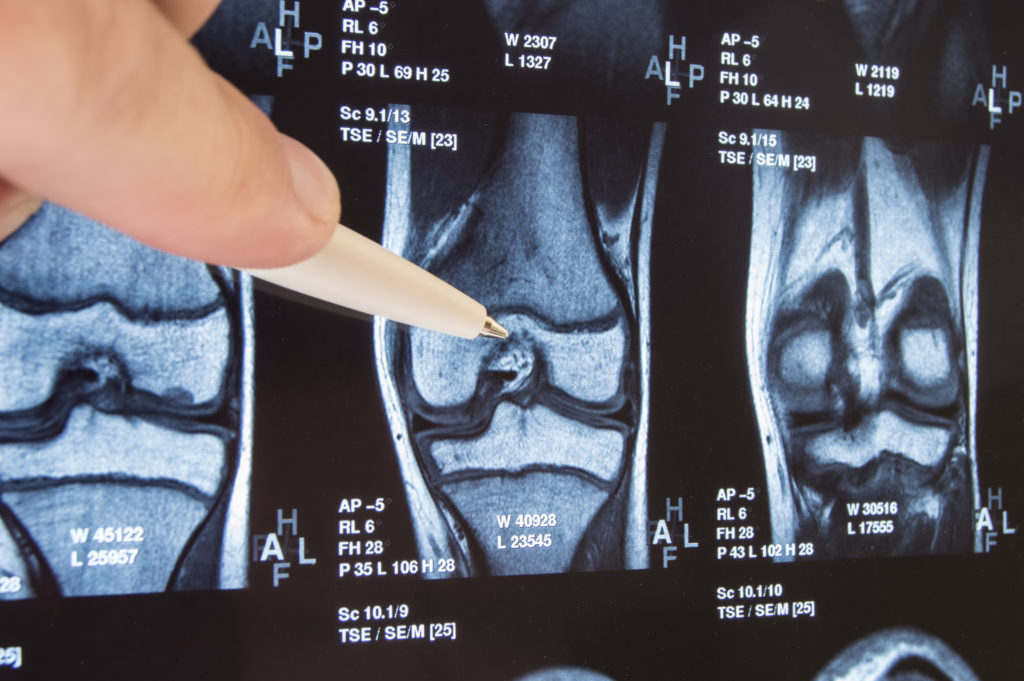THIS POST IS PART OF THE ULTIMATE GUIDE TO TOTAL KNEE REPLACEMENT
Arthritis is inflammation of one or more of your joints and there are more than 100 different forms of arthritis that can affect a variety of joints in your body; however, knee arthritis is especially common.
Read on to learn about the different types of knee arthritis and treatment options available to relieve your knee pain.
Anatomy of the knee
To best understand knee arthritis, it helps to learn the different parts of the knee and how they come together.
Two bones meet to form your knee joint: your femur (upper leg bone or thighbone) and tibia (lower leg bone or shinbone). Your patella (kneecap) sits in front of the joint. Bones are connected to other bones by ligaments.
The ends of the bones in the knee joint are covered with articular cartilage. Cartilage is a smooth, slick substance that protects and cushions the bones as you bend and straighten your knee.
Primary types of knee arthritis
The most common types of knee arthritis are osteoarthritis and rheumatoid arthritis. Arthritis can also develop after an injury. The three primary types of knee arthritis are:
- Osteoarthritis: This is the most common form of knee arthritis. It is a degenerative wear and tear type of arthritis where the cartilage in the knee joint gradually wears away. This causes bone rubbing on bone and can produce bone spurs. Osteoarthritis develops slowly, and the pain increases overtime.
- Rheumatoid arthritis: A chronic disease that attacks multiple joints throughout the body. It can affect the same joint on both sides of the body. The synovial membrane that covers the knee joint begins to swell, which results in knee pain and stiffness. Rheumatoid arthritis is an autoimmune disease which means the immune system attacks the body’s own tissues and damages the cartilage and ligaments while softening the bone.
- Post-traumatic arthritis: A form of arthritis that develops after an injury to the knee, such as a broken bone, meniscal tear or ligament injury. These injuries can cause instability and additional wear of the knee joint that over time can lead to knee arthritis.
What are the symptoms of knee arthritis?
The most common symptoms of knee arthritis include:
- A painful and inflamed knee
- Pain that develops gradually over time
- Stiffness in the knee joint, which makes it difficult to bend and straighten the knee
- Activity is followed by pain in the knee joint
- Knee locks or sticks during movement
- Knee creaks, clicks, grinds or snaps
- A feeling of weakness or buckling in the knee
Physician examination
To determine if you have knee arthritis, your physician will ask you for a complete medical history, have you describe your symptoms and conduct a physical examination. An X-ray or MRI may be necessary to confirm the diagnosis and determine if there are other problems.
Make an appointment with an orthoindy knee specialist
How do you treat knee arthritis?
There is no cure for knee arthritis; however, there are a number of treatment options that can relieve pain.
Typically, all treatment for arthritic symptoms will initially start with nonsurgical treatment options including:
- Activity minimization such as switching from high impact activity to low impact activity
- Weight loss
- Physical therapy
- Assistive devices such as a cane or shoe inserts
- Medications, the mainstays of medication therapy are the NSAIDs (non-steroidal anti-inflammatories) such as ibuprofen. Tylenol can also be effective.
- Corticosteroid (cortisone) injections
- PRP injection
- Tissue and cell therapies
If nonsurgical treatment options offer no pain relief, your physician may recommend surgery. The type of knee surgery depends on your arthritis and symptoms. Some surgery options include:
- Arthroscopy: A small incision is made to treat joint problems; not especially common and primarily used when arthritis is accompanied by a degenerative meniscal tear.
- Osteotomy: Either the tibia or femur is cut and then reshaped to relieve pressure on the knee joint; used when you have early-stage osteoarthritis that has only damaged one side of the knee, and used only for young, very active patients.
- Partial knee replacement or total knee replacement: Your physician will remove the damaged cartilage and bone, and replace it with new metal or plastic joint surfaces. These are highly successful and are a mainstay of surgical treatment for knee arthritis. Advances in technology have made this procedure much safer, reliable and recovery has become much easier.
Rehabilitation
Physical therapy during knee replacement recovery may be recommended to regain strength and motion in your knee. Sometimes a knee brace, crutches or a cane will be necessary temporarily (i.e., for a few weeks) after knee replacement surgery.
Learn more about joint replacement surgery at OrthoIndy

Schedule an appointment
Your well-being is important to us. If you have knee pain and are considering knee replacement surgery, schedule an appointment with one of our orthopedic specialists to review your options.
If your injury or condition is recent, you can walk right into one of our OrthoIndy Urgent Care locations for immediate care. For rehabilitation and physical therapy, no referral is needed to see one of our physical therapists.

The Ultimate Guide to Knee Pain Relief
Take control of your knee pain, learn about treatment options, and find out if surgery might be able to help you get back to normal.





